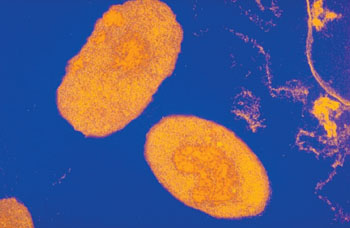Oral Fluid Testing Established for Pertussis
By LabMedica International staff writers
Posted on 19 Jun 2014
Existing surveillance systems for pertussis or whooping cough are inadequate and tend to be biased toward identifying severe cases in infants, as reflected by extremely high reported incidence for this age group.Posted on 19 Jun 2014
Bordetella pertussis, the causative agent of pertussis, has been isolated from the nasopharynx by use of conventional microbiological techniques. However, culture requires that a specimen be collected early in the illness and might lack sensitivity because the organism is delicate, and any delay in processing specimens can reduce the probability of isolation.

Image: Electron micrograph of the bacterium Bordetella pertussis, the causative agent of pertussis (Photo courtesy of Sanofi Pasteur).
Microbiologist at Public Health England (Colindale, London, UK) have introduced a new oral fluid testing service that was pilot tested throughout England and Wales. When a case was reported, if the diagnosis had not been confirmed by culture, polymerase chain reaction (PCR), or serologic testing, oral fluid sampling kits were mailed either directly to the patients or to the parents/guardians of patients, as the kit was suitable for use at home, or to their general practitioner. The sampling kit contained an ORACOL saliva collection swab (Malvern Medical Developments Ltd, Worcester, UK).
Oral fluid was eluted from each swab and tested for immunoglobulin G (IgG) against pertussis toxin by enzyme-linked immunoassay (ELISA). During the oral fluid pilot testing period, 2,756 oral fluid kits were sent, 2,587 clinical cases were reported, and 2,443 cases of pertussis were confirmed by at least one laboratory method. Of these confirmed cases, 751 were confirmed by oral fluid testing plus or minus other methods and 591 (24% of all cases) were confirmed by oral fluid testing only, which increased laboratory ascertainment of pertussis by 32%, and a maximal increase of 124% occurred among children 5 to 9 years of age.
The authors concluded that the introduction of serologic testing followed by oral fluid testing has successively narrowed the gap in surveillance for pertussis in England and Wales. Patients whose pertussis was confirmed by oral fluid testing were least likely to be hospitalized, suggesting that milder community cases were being confirmed by this method. Oral fluid testing is an easily administered, noninvasive surveillance tool that could further our understanding of pertussis epidemiology and thereby contribute to decisions on vaccination strategies. The study was published in the June 2014 issue of the journal Emerging Infectious Diseases.
Related Links:
Public Health England
Malvern Medical Developments Ltd.













